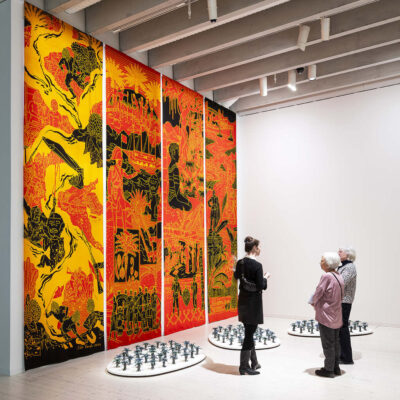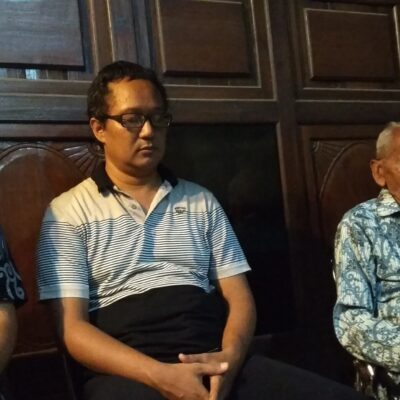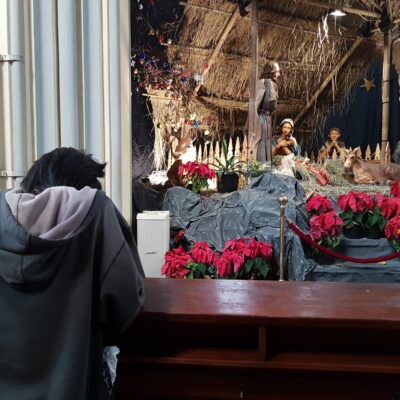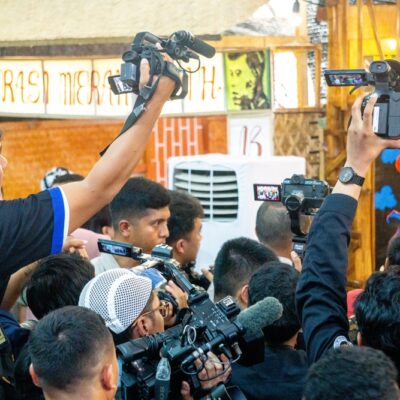Indonesia is home to some of the greatest anthropogenic (caused by humans) disasters in Southeast Asia. These include the toxic haze threatening parts of Indonesia, Singapore and Malaysia due to forest clearances for palm oil plantations in Sumatra and Kalimantan; the chemical and other waste destroying life in and around the Citarum River in West Java, commonly dubbed ‘the worst polluted river in the world’; the plastic waste polluting the Indian ocean and the beaches of Bali and other islands; and the environmental degradation in West Papua due to the exploitation of the Grasberg Mine, one of the largest gold and copper mines in the world.
These calamities have been impacting heavily not only on the natural environment, but also the health, culture, lifestyle and identity of local societies. However, local citizens have not remained silent. Among the most active and vocal are visual artists, who have used their creative talent to raise public awareness, instigate action and generate imaginative alternatives or practical solutions.
Many artists discuss natural disasters not in isolation, but in relation to broader social, political and historical processes and injustices. Their work contributes to a more comprehensive understanding of the causes and impact of anthropogenic disaster. By addressing the histories, memories and traumas of destructive economic development, they demonstrate the interconnections between environmental deterioration and human rights violations in Indonesia. Moreover, they suggest solutions that require profound socio-political renewal, beyond the realm of quick, but in the long term potentially even more detrimental, artificial interventions in life and climate systems. This renewal involves, among others, generating better understanding of the socio-political roots of environmental injustice; strengthening resilience to disaster through individual or communal trauma healing; involving previously marginalised groups and alternative sources of environmental knowledge; and promoting creative collaborations and imaginative ideas towards sustainability.
Interlinking historical violence, economic development and environmental destruction
One of the main political factors that have shaped Indonesia’s natural environment, material infrastructure and social life is the economic development (pembangunan) during President Soeharto’s New Order regime. This authoritarian regime attempted to promote ‘order’ through a combination of development programs and state and military control aimed at depoliticising society. It presented itself as a correction to the socio-political upheaval and economic recession during the final stages of Sukarno’s presidency, retrospectively dubbed the ‘Old Order’. The New Order regime’s ideological path was paved with the annihilation of the Indonesian Communist Party (PKI) and the massacre of at least 500,000 members and alleged members of the party in 1965–1966. Throughout the New Order, freedom of speech and other civil liberties were strongly curbed, and the media were subject to state propaganda and censorship designed to promote economic advancement. But Pembangunan widened the gap between rich and poor, between Jakarta and the rest of Java, and between Java and other parts of Indonesia, particularly eastern Indonesia.
From colonial times to the present, visual culture, including art, has played a crucial, but oft-neglected, role in endorsing as well as resisting ongoing processes of human and natural exploitation.
Made Bayak (b. 1980) and Setu Legi (b. 1971) are two of the most prominent Indonesian artists who refer in their work to the historical interconnections between environmental degradation, social injustice and political and visual discourses. They can both be considered ‘artivists’ as visual art and environmental activism are inextricably intertwined in their ideas and practices. Bayak is one of the leading figures of the ForBali (short for Forum Bali Tolak Reklamasi, the Balinese Forum for Rejecting the Reclamation) campaign, a protest movement against the natural and social impact of a major land reclamation project at Benoa Bay in Bali. He is also known for his ‘plasticology’ campaign against plastic pollution on the island. This campaign incorporates plastic rubbish as a medium in an ongoing series of art works, collaborations and educational programs. Bayak historicises and politicises the land reclamation and plastic pollution by referring to the processes that have led to the (over)development of Bali as an exotic tourist destination, including the mass violence in the mid–1960s and the New Order’s Master Plan for the Development of Tourism in Bali in the early 1970s.
For instance, for his mixed-media work Industry, Hidden History and Legacy of the Island of the Gods (2013), Bayak modified a landscape painting in exotic, so-called ‘Beautiful Indies’-style from a local tourist shop with drawings of modern buildings, walls, and construction sites. He filled the lower edge of his collage with pointillist drawings of skulls and bones, which referred to Balinese mass graves from the anti-communist violence of the mid-1960s. For the artist, the graves constituted the foundation of the cultural and economic development programs since the New Order, including the branding of Bali as a tourist paradise. While local communities have organised large-scale ceremonies to purge themselves of the tragic events of the past, Bayak’s creative work and activism is part of a struggle ‘against forgetting’ (melawan lupa) and supporting fact-finding and critical discussion.
Legi has produced a series of art works that specifically deal with the natural and social impact of oil palm plantations in West Papua. One example is Monokultur (2014), a wall-to-wall and floor-to-ceiling mural, which was partially covered by a series of acrylic paintings (see main image).
Human skulls on a newly constructed highway symbolise the replacement of the original, rich biodiversity of West Papua with the monoculture of palm oil plantations and its deadly impact on nature and the population. The mural included banners with the slogans Gemah ripah loh jinawi (‘Very prosperous and very fertile’) and Toto tentrem karto raharjo (‘Order and prosperity’). During and after the New Order, these well-known Javanese slogans have frequently featured in government campaigns. Legi depicted the gap between the ideals expressed in the slogan and the reality of the environmental and socio-cultural destruction deemed necessary to achieve some of those ideals.
One of his other installations, Tanah merah (‘Red earth’, also referring to a town in Papua province; 2009), consisted of an acrylic painting and 15 terracotta heads, drowning halfway in a flow of mud. The painting showed the activity of a logging company in a forest, and a river full of tree trunks floating downstream. It also included a written poem, next to a figure in traditional Papuan attire, which refers to the impact of excessive logging, including soil erosion and physical and cultural displacement, on the wellbeing of people in Tanah Merah. The reference to this place confirmed continuities between colonialism and neocolonialism, as Tanah Merah functioned under Dutch colonialism as a penal colony for communist and nationalists. Both Monokultur and Tanah Merah can be seen as courageous and socio-politically significant gestures from a Javanese artist, using Javanese cultural symbols, to publicly express concern about, and solidarity with, marginalised communities in a relatively isolated part of the country.
Cultural and religious traditions towards environmental sustainability
Bayak and Legi identify how historical political ideas and practices have not only led to environmental destruction, but also to the silencing of cultural and religious traditions that embody alternative models and sources of wisdom for more balanced relations between humans and nature. The Indonesian 1945 Constitution aims to guarantee freedom of religion for all Indonesians, but the state has given preferential treatment to the six ‘official’ religions of Islam, Protestantism, Roman Catholicism, Hinduism, Buddhism and Confucianism. Bayak, Legi and other artists explore models of environmental sustainability based on other, mystical and syncretic traditions, which have become increasingly under threat with the rise of Hindu nationalism in Bali and more fundamentalist forms of Islam elsewhere in Indonesia.
For instance, in Senjakala Bali Dwipa/Twilight Times of Bali Island (2014), Bayak added sketches derived from rerajahan or mystical drawings.
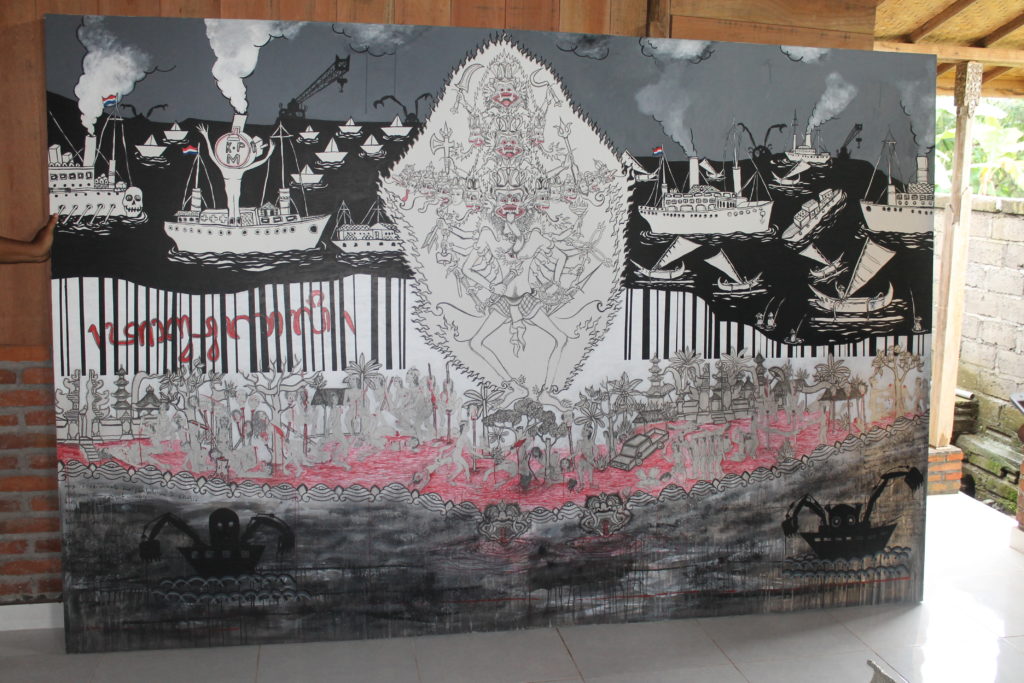
Made Muliana Bayak, Senjakala Bali Dwipa/Twilight Times of Bali Island, 2014. Image taken by the author, 24 January 2018, Made Bayak Studio, Sukawati, Gianyar.
The sketches represent traditional Balinese values particularly karma pala—the belief that people’s souls will be punished for sins committed during life, which in this case refers to the intersections between colonialism, materialism, overdevelopment and environmental destruction. In some of his work, Legi has reflected on the interrelations between Islam and kejawen, a Javanese-style Islamic religiosity, which has absorbed Indic and indigenous religious heritages including various forms of mysticism (kebatinan). For instance, the installation The Chorus Offering Compliments (2015) included photographic reproductions of the artist in traditional Javanese apparel, while engaging in the characteristic poses of Islamic prayer. It also showed how the artist in a barren landscape of cut trees expressed his devotion to nature by bowing and touching the earth with his head. The installation seemed to say that environmental care requires true inner spirituality, but is also under constant threat of fundamentalist belief practices that strongly rely on superficial outward appearances.
One of Indonesia’s leading female artists, Arahmaiani (b. 1961), also engages with cultural and religious traditions, including kejawen, Islam, Buddhism and Hinduism, to politicise and historicise anthropogenic disaster and explore alternative models for a more sustainable future. She has presented herself as a ‘nomadic’ artist, with environmental art and activist projects in Indonesia and elsewhere, particularly Tibet. Her nomadic lifestyle has been partially the product of self-exile. In the mid-1990s, she felt forced to leave Indonesia after receiving death threats from Islamic hardliners, who objected to the combination of Malay in Arabic characters and male and female genitalia in her painting Lingga-Yoni (1994). At the same time, the artist’s international travels and collaborations have enabled her not only to deepen her knowledge about organic farming and other practical solutions to environmental destruction, but also study relatively underexplored aspects of Indonesia’s political and religious histories. It has helped her to imagine alternative notions of the homeland, which in themselves can contribute to more comprehensive and inclusive models of social and environmental renewal.
In 2010, Arahmaiani started to work at the Buddhist Labu monastery in the Kham region of the Tibetan Plateau, after the area was hit by an earthquake on April 14. During the first five years of regular visits to the monastery, she facilitated various environmental projects, ranging from garbage collection and rubbish recycling to water management, tree-planting, organic farming and reviving nomadic life and culture. After attracting the participation of surrounding villagers, the Chinese government eventually decided to join and support the programmes. However, Arahmaiani does not want her environmental activism to be restricted to a materialist approach that merely focuses on forest, water and land conservation or the promotion of organic food. Instead, she proposes a deeper, and more sustainable, approach, focusing on ‘the values and ethics of life that support the harmony and respect for nature and the environment’.
One of her works that has been inspired by the cultural connections between Tibet and Indonesia, and the links between religion and nature, is Memory of Nature (2013–current).
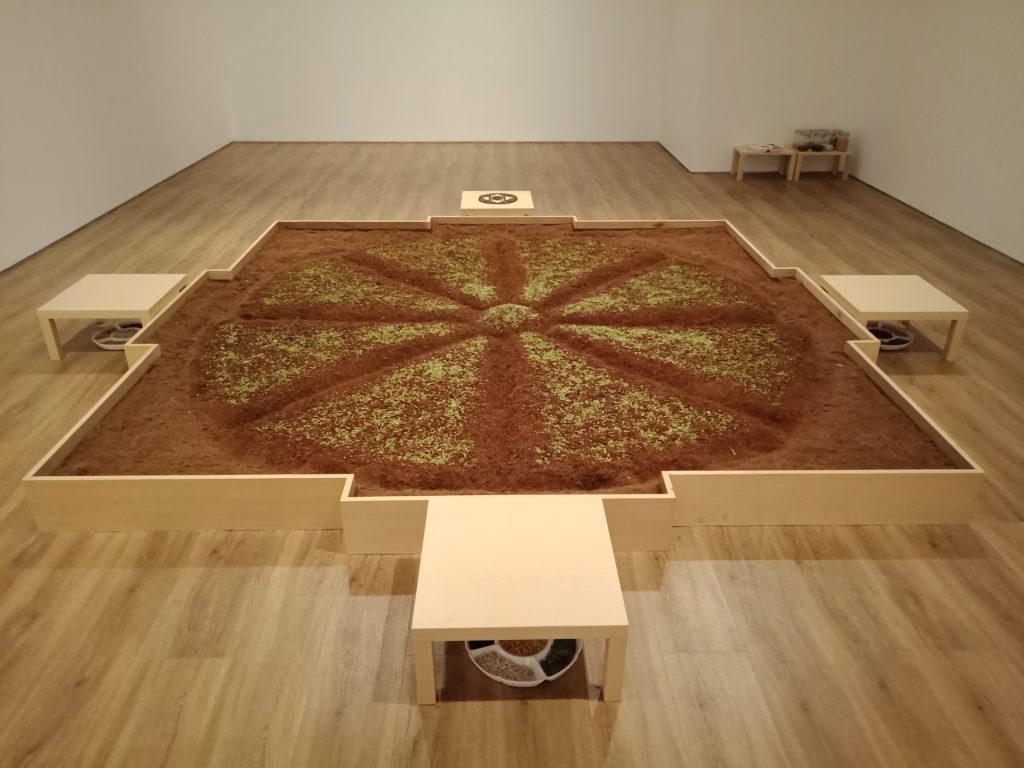
Arahmaiani, Memory of Nature (2013–current); image taken by the author, 28 November 2018, Museum MACAN, Jakarta.
The installation consists of wood, soil and seeds, shaped in the mandala form of the ground plan of the Borobudur in Central Java, which is the largest Buddhist temple in the world. In performances, Arahmaiani and audience members water the soil and seeds, so green shoots of plants can grow from the low, wooden structure. The mandala shape represents the cosmos with all its components, while the plants symbolise a cycle of growth, fruit-bearing, ripening, decay and regrowth. The plants mirror the religious principles of ascension and descension that are central to the architecture of the Borobudur. With this and similar projects, the artist attempts to promote deeper historical understanding about Buddhist cultural heritage and living traditions in Indonesia, and counter the narrow religious-nationalist causes and discourses of increasingly militant Islamic groups.
While Islamic radicalism has been on the rise in Indonesia, post-New Order democratisation has also brought more opportunities for indigenous communities to represent themselves, including their own languages, cultures and belief systems. Urban-based art collectives have been playing a role as their cultural and creative collaborators, mediators and interpreters. Some of the urban-rural initiatives aim for sustainable solutions by combining traditional knowledge about the environment with contemporary art and digital technology. An example is the Kasepuhan Ciptagelar community in Mount Halimun-Salak in rural West Java, which has attracted the attention of outsiders, including artists, academics and tourists, because of its unique environmentally friendly agroforestry practices. The community’s relationship with nature influences, and has been influenced by, its social structures and religious beliefs, which include a mix of Islam, Hinduism and Sunda Wiwitan animist beliefs.
Since 2016, the community has worked with the Bandung-based new media art collective Common Room Networks Foundation. Together with various other partners, they have identified four community priorities: environmental protection and conservation, cultural preservation and development, local Information and Communication Technology infrastructure, renewable energy development, and local economic empowerment and livelihood improvement. One of the outcomes has been the establishment of open-source data centres, which are powered by solar energy. The data centres aim to assist with indigenous knowledge management as well as making information about Kasepuhan Ciptagelar accessible to the outside world. The partners have also combined modern technology, such as Global Positioning System tagging and drone-mounted cameras, with traditional territorial border-marking methods, such as prayers and offerings to ancestral forest spirits. Photos of these traditional activities can provide legal evidence to support indigenous land claims. The mapping has also assisted with the analysis of hydrological sources for farming and examining the relationship between weather conditions and rice production results.
On YouTube and other digital sharing platforms, there is now an abundance of audio-visual art projects, documentaries, news broadcasts and amateur videos related to Kasepuhan Ciptagelar. Artists from the community have also hosted and worked with international artists, sometimes through mediation by Common Room Networks Foundation, and have presented their art and culture in festivals, conventions and media outlets in Asia, Europe, Australia and North America. The multiple collaborations and re-mediations are not without their own challenges. For instance, the use of satellites and web cameras for strengthening indigenous land claims in some art projects could potentially serve the antithetical policies and commercial interests of governments and businesses. Also, the promotion of eco-tourism and rural products in other projects can instigate more sustainable production and consumer habits, but may also serve the capitalist need for the diversification of commodities and markets. A key question that deserves ongoing attention is whether urban-rural artistic entanglements develop the spirit of the coeval commons or rather fortify existing ideological hierarchies in contemporary art and society.
Reconnecting with history and tradition for a sustainable future
In sum, some of the Indonesian artists identify the historical roots and socio-political contexts of anthropogenic disaster, while others seek to renew interest in and acceptance of previously marginalised cultural traditions and religious beliefs that can contribute to scenarios for a more sustainable future. Through their public prominence, visual strategies and imaginative skills, they have the ability to share their multi-dimensional approach with civil society as a whole, and to call for action and change. The alternative, to discuss and apply technological solutions to environmental issues in isolation (not uncommon in hegemonic social, political and business discourses), runs the risk of objectifying the natural environment, which has been one of the causes of its historical exploitation in the first place.
Main image: Setu Legi, ‘Monoculture’ (2014). Image taken by the author, 15 January 2015, Ark Galerie, Yogyakarta.

